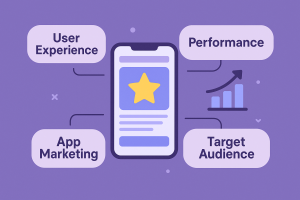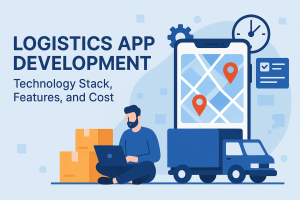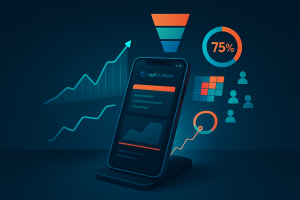The Apple ecosystem’s success is attributed to its remarkability and innovation in creating an extensive array of products such as iOS-powered smartphones, iPads, and macOS drives. Setting high-design approaches with innovation has optimized Apple devices for seamless integration. iOS products have hit a milestone such as lending a 53% share of smartphone sales in the US. Apple is bringing continued revenue growth, holding around 29% of the global mobile operating system market.
Since the demand and utility of the iPhone have considerably increased over the years, there has been a constant increase in iPhone users. It is estimated that more than 1.382 billion consumers are currently using iOS phones. App ecosystems and services have been widely adopted by business professionals, entrepreneurs, and other individuals for seamless integration, compatibility, innovation, and user-centric designs. The strengths of highly innovative Apple products such as Phones and iPads reflect brand identity, originality, and creativity. These highly valued brands present high-quality technological solutions that businesses require. Additionally, the ecosystem’s seamless and versatile nature and innovative iOS application features comprising consistency, accessibility, hierarchy, clear and easy navigation, and responsiveness influence the users to keep coming back and using IOS smartphones or tablets to perform different tasks like User Testing for Your Mobile app.
However, Apple iPhone users encounter several issues such as network and connectivity issues, low memory and data loss, missing updates, overheating and crashing of apps on iPhones, and malfunctioning of the volume button and touchscreen. To overcome these common iPhone problems and boost the overall user experience allow iPhone app development services in USA to adopt Apple’s ecosystem strategies. The Apple ecosystem approach integrates leading innovation and technology to offer seamless device interoperability, improve cross-device functionality, and promote a recurring revenue model. Thus, leveraging Apple’s ecosystem brings users a unified, more connected, engaging experience.
Importance of Addressing Common Application Issues During the Design and Development Phase
While planning to create custom iOS apps, professional iOS app developers integrate highly interactive functions and user-centered designs and features that specifically meet the target market choices and trends. However, new developers who lack app development experience cause major iPhone developmental issues. An amateur app development team that does not give importance to the brainstorming and planning phase is unable to prepare and plan and is incapable of generating a range of ideas and concepts, features, functionalities, and designs for their upcoming iOS application. Moreover, insufficient market and audience research would not let developers know about users’ interests, choices, or pain points. Consequently, developing an app without proper research and understanding of the desired target audience leads to flaws in app development.
iOS app development also comes up with challenges related to creating intuitive UX designs that boost user experience. UX designers and programmers lacking UI/UX design experience create complex interfaces with critical UX components and multiple layers of functionality. A difficult interface appears to be boring and confusing for users to understand and interact with the app. Moreover, the devices that are solely tested by simulators do not facilitate app developers in knowing issues related to design, development, performance, and compatibility. Overlooking performance optimization also causes disorganized codes, increases loading time, and low network connectivity.
Finding major iOS app issues during the design and development phase to proactively address potential problems, minimize costly fixes later in the development cycle, and improve overall user experience. Developers learn to prioritize user experience and create easy and user-friendly applications by integrating engaging visual hierarchies that make navigation convenient for the users. Choosing the right development approach allows developers to focus on device compatibility. Using various device configurations enhances app stability and ensures that the app is operating well on different devices. Thus, detecting mistakes in iOS app development at the early phase of development keeps iOS developers engaged in defining their app’s goals, and objectives and prevents complex paths to complete the app development process.
How Developmental Issues Affect User Experience and App Success
Realizing the significance of app development globally, hire iOS app developer in USA focus on the consequences of app development issues that lead to critical issues such as performance issues, compatibility, and accessibility issues. Consequently, apps that are not optimized for different devices and operating systems, with varying screen sizes, resolutions, and other complex features reduce user experience. Moreover, security issues lead to data breaches and privacy issues.
Let’s look in detail at the consequences of mobile application development issues on users and how they adversely impact app development!
Inaccessible Applications Causes Low User Engagement
As you plan to develop an app, your initial priority is to create an application that resonates with the targeted audience’s preferences and choices. It implies iOS app developers build customer-centric apps. If apps are not user-friendly and have complicated and dull interfaces and difficult navigational buttons, it causes inconvenience in navigating the app. With unintuitive navigation, users get frustrated and struggle to get access to navigation controls such as menus, buttons, and icons. Consequently, users encounter slow loading times, inconsistency of designs and screen sizes, unclear instructions, and other challenges that make them lose interest in app browsing. Many users either do not actively interact with the app or completely abandon the app.
Network Latency Affect Server Performance
Let’s suppose, the users continuously complain of inefficient application response and substandard performance. It signifies the instability of the application. If the network is inconsistent, the application gets regularly disconnected. It takes an extended time to upload the file, images, or content. To reach task completion, the users keep reconnecting the application. The constant interruption causes disturbances such as network instability, high latency, and slow loading times that demotivate the visitors to browse the application. If developers fail to address network issues during the development stage, it leads to serious consequences such as application crashing and unsatisfactory application performance.
Server Capacity Prevents Bringing High Organic Traffic to the Site
Insufficient server capacity unable to attract high organic traffic to the website. Poor responsiveness of the server deters potential users from navigating the app. Unoptimized server allocation, high latency, and redundant or cluttered coding lead to slow organic growth. Consequently, algorithm shifts and technical glitches prevent developers from receiving a maximum number of synchronized requests from organic users. Hence, user engagement remains low which fails to drive more app traffic to the site.
Absence of Database Optimization
An unoptimized database signifies that the programmers have incompetently written or structured SQL queries that help in data storage or retrieve lost data. Ineffective databases affect the speed and responsiveness of applications. Since queries are not well structured, it results in longer processing and loading times, increases server load, and decreases the application’s overall performance.
Misconfiguration Impact App Security
Inappropriate configurations in the application cause security vulnerabilities. Inept security coding, weak encryption, and inappropriate server settings allow unauthorized entities to enter the misconfigured database and get access to important data. Furthermore, multi-factor authentication and inefficient database queries add extra network requests, leading to security risks, slowing down application performance, and causing frequent app crashes.
Uncovering The Most Common iPhone Problems Face by iOS Users
Performance Issue
Suppose you are a new iOS app developer and have been involved in building a responsive iPhone networking system. At the preliminary stage, you may encounter several performance issues such as the iPhone or iPad running slowly or the iOS device freezing. You are required to check the device storage. Freeing up space in iOS or iPadOS devices automatically installs the app. If you constantly face performance issues, you should close the app and start over on iOS devices. Now check again whether the app is working or not responding. To improve application performance, application experts reinstall the latest version of the app from the App Store. Hence, analyzing the causes of iPhone or iPad apps crashing or freezing lets system programmers know about app incompatibility issues, outdated iOS versions, reduced app storage and battery life, weak or overloaded network connection, and obsolete hardware specifications.
User Experience (UX) and Design Challenges
If you are an active iOS app user and intend to navigate different sections of the app to gain relevant product information. You might be expecting to browse a fascinating and vibrant user interface that enables them to navigate with ease. Many users have access to complex user interface that makes navigation inconvenient. They encounter navigational challenges such as an unresponsive touchscreen, and unappealing visual design elements. Complex navigational bars covering primary navigation bars, search bar, Hamburger Menu, inconsistent screen sizes, inappropriate fonts, and unclear product details. Consequently, the creation and design of ineffective navigational components hinder the iPhone experience.
Creating an intuitive and striking user interface implies iOS app development companies hire iPhone app developers in USA who possess knowledge about user interaction design patterns, choices, and trends. Having a vast UI/UX design experience enables them to develop intuitive, and visually appealing interfaces that capture customer’s attention. Expert UI/UX designers integrate unique and attractive UX designs, color schemes, and typography that match the targeted customer’s choices, interests, and trends. Building intuitive interfaces counts on the designer’s existing knowledge and understanding to create simple, easy, and engaging interfaces. Navigating a user-centric interface with consistent designs, innovative styles, color patterns, readable fonts, and appealing icons minimizes the cognitive load and builds a positive interaction with the app.
To enrich the layout structure, suggest iOS app designers identify the common usability issues that lead to the creation of an unappealing user interface. A cluttered layout with multiple layers, overlapping visual hierarchy, and inconsistent alignment of the layout structure keep users confused with app navigation. If customers persistently feel disengaged, they might end up abandoning the application. Therefore, creative UI/UX designers adhering to Apple’s stringent design guidelines design usable, interactive interfaces that align with the user’s expectations. An eye-catching user interface is expected to be simple, accessible, and engaging which brings a smooth and seamless navigational experience.
App Store Submission and Compliance Issues
Suppose you have invested your time, energy, and resources in building high-functioning applications but you lack compliance knowledge. It refers to comprehending and adhering to the App Store’s rules that demonstrate that keeps the app responsive and functional. Moreover, App Store compliance boosts app visibility and ranking in the App Store. Experienced iPhone app development services in the USA must implement content policies based on Apple’s standards. The iOS app should be updated per Apple’s technical requirements. It includes compatibility updates with new iOS Apple’s operating system for iPhone, iPad, and iPod Touch. Designing user interfaces requires iOS designers to follow the App Store’s rules. Implementing Apple’s interface design principle helps in creating an intuitive user interface with simple navigational bars and components. To make navigation more appealing, the designers add colorful patterns, typography, and visual elements. Integrating high-resolution images and videos related to the brand drives more audiences to visit the application. Furthermore, the design guidelines allow developers to integrate accessibility features in the apps that benefit users with disabilities.
Applying the content guidelines allows developers to use optimized and engaging content that increases organic traffic. Moreover, developers should also gain knowledge of optimizing metadata to let the app discovered on the App Store. Metadata optimization should comply with the App Store compliance guidelines. According to the compliance rules, the iOS app store developer should create relevant and appealing keywords related to the app’s core functions and features. Along with keywords, the experts also use catchy titles, subtitles, and simple and easy-to-understand descriptions that boost app visibility and increase conversion rates.
Following compliance checks and testing helps in identifying bugs, viruses, and other design and development issues that improve application performance and scalability.
Security and Privacy Concerns
Corporate infrastructure encounters several security and privacy challenges in iOS applications such as insecure data storage, weak authentication mechanisms, inappropriate data transmission, inadequate encryption, and vulnerable API protection. Weak security systems provide access to unauthorized entities or third parties to enter the system networks. With unnecessary entrance, the malicious phisher easily gets hold of user data such as contacts, login credentials, financial specifics, and location data. Weak and disorganized codes and poor privacy practices expose confidential data to illegal parties leading to excessive data breaches.
To improve iOS app security, companies hire iOS app developers who conduct rigorous app testing to ensure application security. They can implement robust encryption systems comprising face recognition, fingerprint authentication, and strong security solutions that detect unauthorized access to the security system. Setting strong, unique passwords, or distinct authentication codes secure and safeguard the application networks from security breaches, or unofficial data transmission across separate systems.
To further safeguard applications, developers are required to examine app vulnerabilities. Defects in the app’s source code disrupt device functionality, allowing criminals to get easy access to unencrypted channels. They employ malicious tools and software to disrupt the networking infrastructure of the application and get involved with data leakage, code tampering, and sharing sensitive information on unprotected networks.
To prevent undesirable acts such as data theft, or app functionality disruption, expert developers must keep the application updated. Regularly updating programs and installing the latest versions helps identify unusual or illegal activities in network systems. Using the SSL or TLS protocols, and iOS app penetration testing check the servers and identify security faults.
Thus, employing a comprehensive approach to application security including automated vulnerability scanning and manual pen testing and developing strong and secure encryption techniques improves app permissions, removes vulnerabilities from the application interface, and reduces security risks within the application.
Compatibility and Update Challenges
Many iOS developers are facing compatibility challenges in updating their iOS apps. Since app developers are using different iOS versions, they encounter challenges such as device compatibility and new APIs that affect app performance and functionality. The other compatibility issues include managing different screen sizes, hardware capabilities, and code maintenance. Professional iOS app developers have revolutionized iOS apps by releasing new versions that significantly help in overcoming compatibility issues. iOS app development services test and support a range of iOS versions, allowing iPhone users to upgrade their iPhones. Many users are using 32-bit apps; however, app developers are employing 64-bit technology that optimizes the application’s performance and features. To manage compatibility and update challenges, iOS developers are required to perform rigorous compatibility testing on a variety of iOS devices and versions to address compatibility issues. Regular testing and managing API keep devices updated and synchronized with the latest app development trends. Moreover, integrating new features and bug fixes and managing memory and storage capacities ensure app compatibility and optimal performance of the application across different networks and operating systems.
Network and Connectivity Problems
Creating high-functioning applications requires app developers to check iPhone connectivity issues. Usually, app users complain of slow loading times. It takes an extended time to download videos, high-resolution images, or other visual content. The app consumes a lot of data that causes performance and speed issues. The slow network connectivity, inability to connect to servers, and continuous interruptions delay the uploading time. Consequently, it causes frustration and compels users to exit the application without finishing the action or process.
To optimize the application speed and improve network connectivity iOS developers inspect network settings. They come to know the networking glitches in the application. The obsolete or corrupt network settings in the app, bugs and viruses in the app’s network code, and outdated API integration cause consistent connectivity issues. Moreover, server outages and incorrect proxy settings cause connection failures. To enhance network connectivity, the developers should keep the application updated. Clear app cache, maintaining high coding standards, and resetting network settings reduce networking and performance issues and lead to smooth app functioning.
Monetization and In-App Purchase (IAP) Issues
In-app purchase developers create in-app purchases for mobile apps to generate revenue from their apps. They adopt a monetization strategy that involves app users purchasing digital goods and services on the App Store or using iOS apps. Some of the challenges related to in-app purchasing include creating an Apple Account and adding a payment method to make app purchases. As many iOS users make constant purchasing prompts, it slows down the networking process and makes the purchasing process difficult. Consistent disruption makes users frustrated, forcing them to leave the app without completing the purchasing process. The users also complain of difficulty in payment modes. Technical glitches in the payment system cause unsuccessful purchasing procedures or cause double charges or unauthorized transactions. Furthermore, security issues cause the risk of exposing user payment information across unauthorized networks. The other challenges that users face are confusing price structures that restrict app users from making in-app purchases.
To efficiently handle monetization strategy challenges, iOS developers should strictly implement app store guidelines regarding IAP pricing. Moreover, the developers employ the StoreKit Framework that specifically manages in-app purchases. The framework provides product information, the method to make app purchases, and handling transactions and receipts. With App Store Connect, the developers integrate IAPs into the App Store. It helps programmers create specific product types and add them to the App Store. They add subscriptions, monthly or annually, and set the prices offered by App Store Pricing. Moreover, iOS developers add preliminary offers discounts, and other promotional incentives that boost a positive user experience increase in-app purchases, and expand revenue streams.
Testing and Quality Assurance Deficiencies
Some app testing challenges that developers encounter are testing devices and version fragmentation. Apple devices are available with different versions, screen sizes, resolutions, and hardware specifications. Consequently, testing device configurations remains a challenging task for developers. Efficient testing procedures include testing real devices that have strong hardware configurations, proper network connections, and optimum device speed. Functional testing allows developers to analyze the high standards of UX/UI user interface and navigational bars. The test verifies that UI components are optimized to provide a user-friendly navigation experience.
iOS app testing best practices include Regression Testing that ensures that new changes induced in the application positively impact application features, speed, and performance. While performance and responsiveness tests help optimize the app’s performance. It includes improving battery performance, strengthening network connectivity, and server load. Penetration testing, data security, and privacy testing help in improving app security. The tests detect vulnerabilities and bottlenecks in system networking, prevent security breaches, and keep sensitive data encrypted. Thus, security testing safeguards applications and ensures optimal app performance across different operating networks.
Before app release and deployment in the market, QA experts conduct thorough testing to identify and fix bugs and other design and development flaws in the application. Moreover, the testing experts also examine application features. They incorporate new features based on user feedback to improve a relevant app feature or create innovative applications. Add new functionalities, codes, and API integration to an existing application enhancing application capacity to perform additional tasks and seamlessly run on different devices.
Recapitulate
New advancements in app development have taken the app industry by storm new categories of apps have been introduced in the market to meet the rising trends and choices of app users. As app developers intend to create versatile iPhone applications, they need to inculcate adaptability and knowledge to stay relevant in the market. Furthermore, it allows them to identify the design and development, security, and usability flaws in the application. Understanding the app development issues, the project managers, iOS Developers, UI/UX Designers, and QA engineers are required to stay updated and employ innovations and technologies to resolve technical glitches and issues and create responsive and high-performance applications. The iOS development team should assess the application compatibility issues such as managing different iOS versions across different devices and maintaining compatibility with older versions. Engaging in beta testing enables experts to address potential compatibility issues before app release. UX/UI designers face the challenge of creating an intuitive and high-quality user interface that brings a smooth navigation experience. iOS app designers integrate modern interface designs with aesthetics that help create visually pleasing interfaces.
To improve application speed and performance, the developers conduct performance and responsiveness tests. The iOS app testing examines the application performance in different conditions and highlights the adverse impact on application performance. It includes inconsistent bandwidth, increased latency, low battery, poor network connectivity, and app crashes. Focusing on usability testing, and leveraging automation tools and frameworks assist developers to maintain iterative testing and coding standards that accelerate application function. QA engineers conduct wide-ranging tests to find vulnerabilities and device-specific issues in the application. Developing strong security solutions and real-time monitoring effectively safeguard app users from encountering security breaches and other security risks. Optimizing the application performance implies developers utilizing multiple platforms such as cross-platform that allow apps to run smoothly across different operating systems. Thus, iOS developers have built cutting-edge iOS applications with new functionalities that meet Apple’s design and development standards and lead to personalized user experiences, and seamless interactions.
Frequently Asked Questions (FAQs)
Q1: What is the most common reason for iOS app crashes?
The most common reason for iOS app crashes includes software bugs or technical or functional flaws within the app. Some malfunctions comprise poor coding practices, incompatible iOS versions, low storage space, weak network connection, and corrupted app data.
Q2: How can I improve my app’s performance and speed?
To maximize your application speed and performance regularly update your app. Focus on optimizing your application code, reduce network requests, and execute efficient caching mechanisms. Thus, employing network and image optimization and performance metrics ensures that your app is optimized and compatible with different devices and network conditions.
Q3: What steps should I take to avoid App Store rejection?
To prevent App Store rejection, comprehensively test your app before submission. Meticulously follow Apple’s guidelines regarding features, privacy policies, and design. Before final submission, ensure your app description is complete and accurate. Update the privacy policy that represents your app’s functionality and also highlight how your app handles user data.
Q4: How do I ensure my app is secure against cyber threats?
To ensure that your app is secure against cyber threats, you are required to implement strong security solutions. It includes protecting your user data by creating strong encryption and authentication codes and protocols. Conduct regular tests to update your app and perform iOS app pen testing and security tests that address and fix app vulnerabilities.
Q5: What are the best tools for iOS app testing and debugging?
The best tools for iOS app testing and debugging include Xcode, with significant features like XCTest for functional testing. XCUITest for UI interaction testing, and performance analysis. The other tools include BrowserStack for cross-device testing on real iOS devices, and Charles Proxy for network traffic monitoring within your app.







